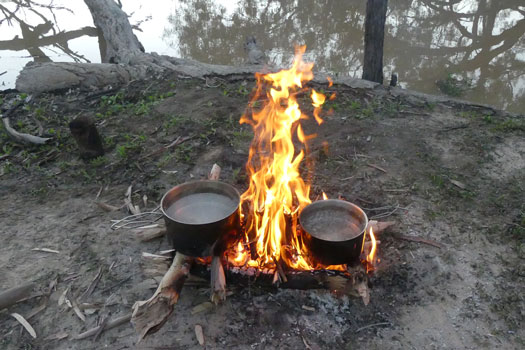Covert Camping
Tips on how to avoid being discovered
In many areas you can directly treat the water before drinking it. But if the water looks cloudy or green, clarify it first before treating it!
Turbid water can settle overnight in many areas. This will ensure a longer life of water filters and to improve the taste of the water. In really bad conditions, chemical agents such as alum (aluminium sulphate) as a flocculant.
Sock filters and Mil bank bags can be used as a pre-filter filter to remove large particulates from the water.
There are a number of chemical agents used, but Alum seems to be the most common and can be purchased in swimming pool supplies. The Alum rate is 15mg/L to 100mg/L and the pH should be within the 6.5 - 7.5 range. The correct dose of alum will flocculate suspended solids in the water together into large fluffy lumps. These will then be heavy enough to settle out the water naturally within an hour or two. It is recommended that you first test in a jar to determine the correct dosage but I found it easier to test the dosage in the final container due to the minimal amount of Alum required.
I found that I really needed hardly any Alum when I used it for the first time. Literally, only 3 pinches were used to treat 13 L of water. If I had the dosage right, you would see signs of flocculation within minutes where suspended particles clump together, and it would take about an hour for the water to fully clear. If it fully cleared within minutes, I would restart with a lower dose. If there were minimal / no signs after 10 minutes, I would increase the dosage. The sedimentation process would usually need at least 5 or 6 hours to complete, so I would leave the container sitting overnight. I also treated myself to clear water in my solar shower, and I just used a higher dose to quickly clear the water. In the field it can be difficult to decant the clean water without disturbing the Alum too. I found a siphon hose great for doing this, borrowed from my solar shower!
For my upper Murray trip, I used a life straw for the alpine areas where there was high water quality, and it worked for 2 weeks before the bag / connections died and I was forced to boil my water. There should be enough towns to simply collect 3 to 6 days at a time. For my Darling trip, town supply water will be carried, but longer legs will require treatment of the rather muddy water. Two step process where the water is first clarified overnight using Alum, then boiling the water on a campfire to treat. A ceramic filter was carried as a backup measure as well as some chemical treatment tablets.

Basically, boil, filter or chemically treat all water before you drink it!
Purchased tablets usually contain sodium chlorite, iodine compounds and / or sodium dichloroisocyanurate. Most should provide effective measures against most pathogenic agents, however Cryptosporidium treatment is limited to sodium dichloroisocyanurate such as those found in Katadyn Micropur Forte tablets as well as some other brands. Treatment takes much longer to ensure all Cryptosporidium is removed, 4 hrs for the Katadyn Micropur Forte tablets.
Water may be disinfected using household bleach containing chlorine, but not containing added perfumes, ammonia or other detergents. Rate depends on the amount of available chlorine (double the rate for turbid water) and allow it to stand for at least 30 minutes. You should notice a slight chloride order but this will dissipate if you let the water stand for longer. It seems harder to find plain bleach these days! The WA government contains a lot of information on emergency water treatment options.
I personally dislike the taste of all of the chemical treatment options, and would only carry water treatment tablets as a last resort option where I couldn't filter or boil the water.
©2026 Alan Davison // Credit // Disclaimer